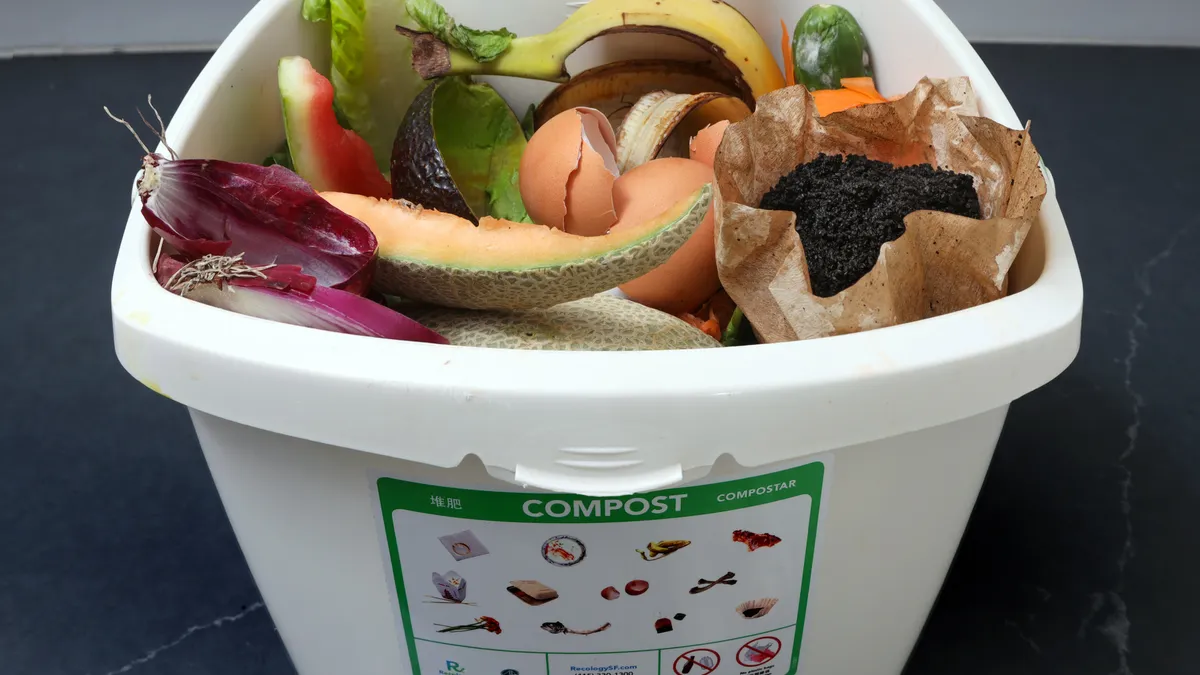Dive Brief:
- Composters spend about a fifth of their operating costs on addressing contamination, a report from the Composting Consortium found. Closed Loop Partners’ Center for the Circular Economy, which leads the consortium, published the findings from their study on Wednesday.
- The report analyzed feedstock and end products from 10 composting facilities, nine of which accept compostable packaging and one that does not. The report aims to establish an industry baseline for the levels of contamination in composting facilities and the costs associated with addressing the issue.
- The report also found that 85% of the contamination detected at composting facilities was conventional plastic. “We need to solve for contamination, and solving for it really starts with measuring,” Paula Luu, a senior project manager with Closed Loop Partners, said during a Wednesday webinar discussing the report.
Dive Insight:
There are about 200 full-scale composting facilities in the U.S. today that collectively manage about 4% of all post-consumer food waste, according to data from BioCycle. Many of those facilities are grappling with contamination, and consumer confusion over compostable packaging has led some facilities to stop accepting it altogether.
The potential for addressing food waste via composting is significant. The report’s authors note that food waste costs the U.S. nearly $430 billion per year, citing ReFED data from 2022. The U.S. estimates 58% of fugitive landfill methane emissions come from food waste.
The Center for the Circular Economy believes that scaling the processing and collection of compostable packaging can help the composting industry broaden its reach. The consortium — which includes a range of members such as the U.S. Composting Council, Biodegradable Products Institute and brands such as PepsiCo — launched in 2021 with the goal of advancing this discussion.
“I think the composting industry is at an inflection point, and to meaningfully address food waste, the industry needs to spur investment and industry action to establish composting manufacturing as a viable solution for food waste at scale,” said Caroline Barry, a project lead for the Composting Consortium.
The report looked to address several common assumptions about contamination caused by packaging, including the idea that accepting compostable packaging leads to greater contamination levels. The report found that this was “not necessarily” the case.
“Most composters had contamination, irrespective of whether or not they accept compostable packaging,” researchers reported.
The researchers examined facilities that were a range of sizes from around the country. This included consortium members such as Ag Choice, Atlas Organics, Black Earth Compost, Napa Recycling, SET (a subsidiary of WM) and Veteran Compost.
They found that every facility implemented hand-sorting for contamination at some point in their process, but that facilities with sort lines and other mechanical processes spent half as much time decontaminating feedstock as those without machinery.
The report also found that compostable packaging was largely performing as advertised, as eight out of nine participating facilities had no detectable amounts of the material in their finished compost.
The report’s findings are further evidence that the composting industry needs to work with packaging brands and other upstream stakeholders to address proper labeling, said USCC Executive Director Frank Franciosi on the webinar.
“We have to go upstream and we have to try and stop it at the faucet first and also advocate for legislation that makes the compostable packaging more uniform and really chastises the lookalikes,” he said.
Franciosi also noted that growing extended producer responsibility programs could provide an opportunity for composters. He said that while most of the revenues derived from those kinds of programs would go toward recycling plastics, there could still be money available for educational campaigns and other ways to reduce compost contamination.
The study also looked to establish a cost baseline as a way for composters to factor contamination into the price of their final products or tipping fees. The composters surveyed spent an average of 21% of their operating costs on contamination removal and in some cases tip fees did not cover these costs. Even still, 40% of the composters surveyed still had some plastic in their finished product.
“If these findings hold true at scale and contamination happens regardless of your acceptance policy, your business model, regardless of throughput, it’s critical we find ways to compensate composters for this reality,” Barry said.















